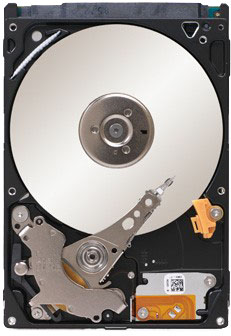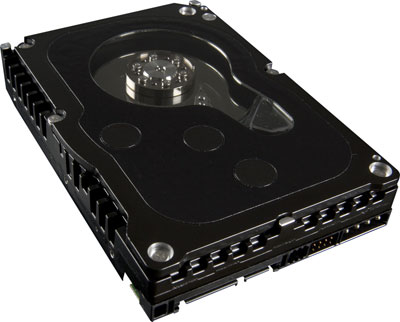In The Lab With Seagate's Momentus XT 750 GB Hybrid HDD
More than two years after reviewing Seagate's first-generation Momentus XT, we're back in the lab with a 750 GB model armed with 8 GB of SLC NAND and a SATA 6Gb/s interface. How does it compare to pure solid-state and hard drive technologies? We dig deep.
Comparing Mechanical, Solid-State, And Hybrid Storage
In order to create our comparison, we're using Seagate's Momentus XT, which combines 8 GB of SLC NAND, a 32 MB cache buffer, 750 GB of magnetic media spinning at 7200 RPM, and a SATA 6Gb/s interface.
When we first reviewed Seagate's hybrid hard drive technology, the Momentus XT only had 4 GB of SLC NAND. Moreover, the model we tested was limited to a 500 GB capacity and a SATA 3Gb/s interface. In that first-generation implementation, along with the Momentus XT we're testing today, a small repository of SLC NANDis used to intelligently store hot (or repeatedly-requested) data.
This isn't strictly storage space where data goes once it's read more than once. Rather, the drive moves information that is determined would exceed a certain access time if it had to be pulled from the mechanical media. And it doesn't necessarily move complete files, either. If a read operation is slowed down by just a single fragmented block, then only that piece of the file will be copied to NAND. In theory, this should help reduce the access time penalties associated with conventional disks. On the Momentus XT, read seek times are rated at 11 ms on average, while write seek times average 13 ms.
Maximizing The Utility Of 8 GB
Although 8 GB may not sound like very much, it's not an insignificant chunk of space for storing small blocks of data that would otherwise affect access times in a negative way.
The NAND is primarily used to service read operations. Writes to the flash memory by the device controller occur following a read/write modification, or when more relevant data is transferred to NAND to help accelerate subsequent read operations. When a file (or a portion of a file) held in NAND is subject to a read/write modification, the revised data is modified on the hard disk platter first before it's copied back to the NAND. As a consequence, data integrity is reliant on the mechanical storage, rather than whatever is sitting in the solid-state space.
Writes to the NAND result in a program/erase cycle (P/E). The ability of a flash memory cell to endure many P/E cycles is dependent on transistor geometry, manufacturing process maturity, and the flash technology itself. Single-level cell (SLC) NAND, the type Seagate uses in its Momentus XT, can endure a much greater number of P/E cycles than multi-level cell (MLC) NAND. The trade-off, of course, is much higher cost for SLC NAND, which is why a vast majority of SSDs (even many of the enterprise-class offerings) employ MLC flash.
Get Tom's Hardware's best news and in-depth reviews, straight to your inbox.
Despite its pricey chunk of SLC NAND, the 750 GB Momentus XT currently sells for about $150, translating to a cost per gigabyte of roughly $.20 cents. That's quite a bit more than what you'll pay for a conventional hard drive (Seagate's 750 GB Barracuda goes for $80, or about $.10 cents per gig). However, it's also a mere fraction of what you'd spend on an SSD of comparable size.
The SSD And Hard Drive Competition
We're comparing the Momentus XT to Samsung's 64 GB 830, which offers 59 GB of user capacity. The 830 employs multi-level cell Toggle-mode flash, a three-core MCX controller, and 256 MB of DDR2 SDRAM as a cache. Higher-capacity models include up to 1 GB of DDR2 SDRAM. Newer SSDs with Marvell's controller technology in them are also starting to use up to 1 GB of DRAM cache. Similar to how hybrid hard drives use flash memory for its strength in dealing with fast read operations, SSDs are increasingly turning to DRAM to deal with the weaknesses of NAND: write operations.
The 830 we're using is a fairly entry-level model. Its lower capacity does negatively impact performance. However, it's still able to achieve sequential read performance as high as 520 MB/s and sequential writes up to 160 MB/s. Random 4 KB read IOPS are in the 75 000 range, while random writes top out around 16 000. Samsung's 64 GB 830 sells for right around $90, resulting in a cost per gigabyte around $1.40.
Representing hard drive technology, we're using a Western Digital WD1500ADFD Raptor X 150 GB. It's not the company's most modern model; however, it still performs well compared to newer hard drives. The Raptor X is based on a twin-platter design with a 10 000 RPM spindle, a 16 MB buffer, and support for NCQ (Native Command Queuing). It boasts an average read seek time of 4.6 ms and an average write seek time of 5.2 ms. Track-to-track seek times are rated at .4 ms, on average, and the full stroke seek time comes in at 10.2 ms. When the Raptor X first came out in 2006, it sold for $350, it retailed for $349. Today, you can pick up a refurbished one for less than $60.
Test Setup And Benchmarks
| Test System | |
|---|---|
| CPU | Intel Core i7-2700K (Sandy Bridge), 3.5 GHz, 8 MB Shared L3 Cache, Hyper-Threading enabled, Power-saving features enabled |
| Motherboard | Asus P8Z68-V, Z68 Express Chipset, LGA 1155 |
| Memory | 4 x 4 GB Corsair Vengeance DDR3-1600 |
| Graphics | AMD Radeon HD 6970 2 GB |
| Storage | Seagate Momentus XT 750 GB, SATA 6Gb/s, 32 MB Cache, 7200 RPM |
| Row 5 - Cell 0 | Samsung 830 64 GB, SATA 6Gb/s |
| Row 6 - Cell 0 | Western Digital Raptor X, SATA 1.5Gb/s, 16 MB Cache, 10 000 RPM |
| Software Setup | |
| Operating System | Windows 7 Ultimate x64 Service Pack 1 |
| Intel Chipset Drivers | 10.8.0.1003 |
| AMD Graphics | Catalyst 12.4 |
| Benchmarks | |
| AS SSD | 1.6.4237.30508 |
| Anvil's Storage Utility | Beta 12 |
| hIOmon | Client Version 7.0.229.0 |
Current page: Comparing Mechanical, Solid-State, And Hybrid Storage
Prev Page Hybrid Hard Drives Evolve Yet Again Next Page Benchmark Results: AS SSD-
sunsmasher So it sounds like the hot setup is SSD for OS/Apps, and HHDD for storage of frequently used media, with a 2TB+ hard drive for storage/archiving of other media.Reply -
americanbrian I don't like your spider graph for reliability.... Does the Hybrid Drive still "work" when either the flash or spinning discs fail?Reply
If not (which it is easy to argue it would at least not be working properly if at all). Then you must say it has twice the chance at failure. This is because if there is a 1:1000 chance of the HD part failing, and a 1:1000 cahnce of the flash failing (your spider shows them to be roughly equal) then there is a 2:1000 chance of "drive" failure in total (or 1:500).
That is called "probability" it is funny like that. Think of it like a weird RAID 0 array. -
hunshiki The idea is great in my opinion, but they could include a 16gb SSD inside the drive. Or 32.Reply -
akamrcrack Would have been nice to see you include SSD caching drives like the Crucial Adrenaline in this study.Reply
My Adrenaline + Samsung Spinpoint F3 1TB 7200rpm HDD say they are the better buys :)
Installed my OS onto my HDD (was originally on a Crucial M4 64GB) then installed the Caching software from Dataplex and watched the sparks fly!
Now my Spinpoint runs as fast as my Intel 320 series 120GB SSD in CrystalDiskMark :)
Plus I can always upgrade to a 2TB HDD meaning I can have 2TB of space running at SSD speeds all day :)
When you are a srs gamer like me and you have hundreds of games to store and no SSD capable of holding them, you begin to want to find solutions to solve that. Well ever since I installed the caching drive + software (very simple) everything about my HDD is fast!
Momentus is old and tried. The only thing I know of that can match the performance of my HDD+SSD cache is a new gen velociraptor 1TB HDD that costs around $320. Which could get me 2TB of storage and the SSD cache and still have money left over lol so neither new gen raptors or momentus are worth the cost unless you are limited to 1x 3.5" bay in your computer.. Even then a 2.5" SSD is very easy to hide in a case..
I've seen the argument "why not just get a regular SSD instead of the Adrenaline, won't they do the same thing?"
My response to that is, for the average user that wants simplicity getting a SSD premade for caching that comes with quality software is the way to go. The Dataplex software is very very light and as simple as install then forget it existed. -
A comparison with Intel's SRT technology (combines up to 64GB SSD with a traditional HD) would have been interesting. I wonder what evidence made Intel choose 64GB and Seagate choose 8GB? What is the optimal amount of SSD to pair with an HD generally speaking?Reply
-
mariusmotea To test a Hybrid drive you need to use it several hours. of course that benchmarks files has been cached into the SSD. Let's see the startul speed after i browse the internet for few hours and play a game for 30 minutes. I don't belive that the statup files will be in ssd anymore.Reply -
dthx Of course a SSD + big 3.5 drive is always a better solution but... impossible to achieve in most portable PC's. This is where the hybrid shines: you don't have to choose between decent performances and sufficient and affordable capacity. I've put such a drive (and Win7 instead of Vista) in a 4 year old XPS-1330 and after a few reboots it has become an extremely capable machine (faster than any brand new laptop with a conventional HDD).Reply -
cscott_it I recall another site (maybe Anandtech?) putting a couple of these in a RAID 0 configuration and the performance scaled rather nicely. Any chance you guys are thinking about doing something like that?Reply


